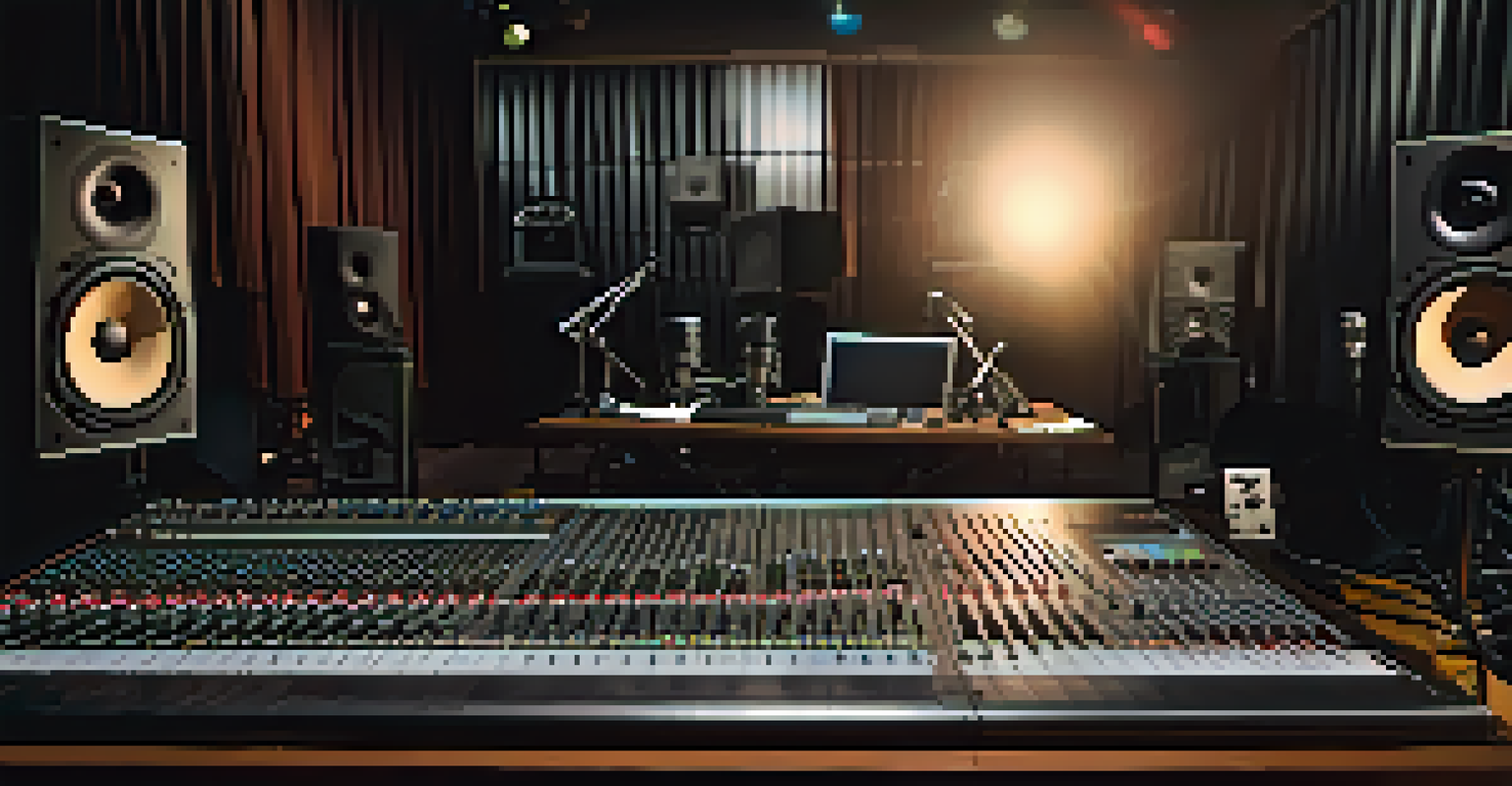Live Sound Recording Techniques for Performances

Understanding the Importance of Live Sound Recording
Live sound recording captures the energy and authenticity of a performance, making it crucial for artists and producers. This technique not only preserves a moment in time but also allows listeners to experience the atmosphere as if they were there. Whether for a concert, theater production, or corporate event, effective live sound recording can elevate the overall quality of the performance.
Music is the shorthand of emotion.
Imagine listening to your favorite band live; the sound, the vibe, and the crowd all contribute to a memorable experience. A well-executed recording can transport those who weren’t there into the heart of the action. This is why understanding the nuances of live sound recording is essential for anyone looking to preserve the magic of a live performance.
Moreover, with the rise of streaming services and digital platforms, the demand for high-quality live recordings has soared. Artists and sound engineers alike must hone their skills to meet audience expectations in this competitive landscape. Ultimately, mastering live sound recording can pave the way for greater opportunities in an artist's career.
Choosing the Right Equipment for Live Sound Recording
The foundation of excellent live sound recording begins with selecting the right equipment. Microphones, mixers, and audio interfaces play pivotal roles in capturing the true essence of a performance. For instance, dynamic microphones are ideal for loud environments, while condenser mics excel in quieter settings, making it essential to choose according to the specific needs of the performance.

Additionally, a quality mixer allows for real-time adjustments, ensuring that the sound remains balanced throughout the event. Investing in good headphones is also vital; they help sound engineers monitor the mix accurately, preventing any unpleasant surprises during playback. Remember, the right gear can make all the difference in recording clarity and quality.
Importance of Live Sound Recording
Capturing live performances preserves their energy and authenticity, allowing audiences to experience the atmosphere as if they were there.
Lastly, don't overlook the importance of cables and stands. Even the best microphones can underperform with poor-quality cables or unstable stands. A solid setup not only enhances the recording quality but also ensures a smoother workflow during the performance.
Setting Up Your Recording Environment
Creating the ideal recording environment is just as important as having the right equipment. Consider factors such as acoustics, positioning of microphones, and ambient noise. Ideally, you want to minimize background noise and reflections that could interfere with the recording quality.
The best recordings are the ones that capture the excitement of the performance and the energy of the crowd.
One effective strategy is to use acoustic panels or curtains to dampen sound reflections in the space. This can help create a clearer sound by ensuring that the direct sound from the instruments and vocals is captured without interference. Additionally, positioning microphones strategically can maximize sound capture while minimizing bleed from other sources.
Finally, ensure that your recording area is organized and free from distractions. A clutter-free environment allows you to focus on the performance and the technical aspects of the recording, ensuring that you capture the best possible sound.
Microphone Placement Techniques for Optimal Sound
Microphone placement can significantly impact the quality of your live recording. Experimenting with different placements can help capture the essence of each instrument and vocalist. For instance, placing a microphone close to a guitar amp can yield a fuller sound, while a more distant placement might capture a more ambient tone.
Using multiple microphones for a single instrument can also enhance the recording. This technique allows for a layered sound, where you can mix the different mic inputs for a more dynamic range. Just remember to consider phase issues, as improperly placed mics can lead to a hollow sound.
Essential Equipment for Recording
Choosing the right microphones, mixers, and audio interfaces is crucial for achieving high-quality live sound recordings.
Moreover, be mindful of the performers' movements on stage. If they tend to move around, consider using wireless microphones or strategically placing stationary mics to ensure consistent sound capture. Ultimately, the goal is to create a balance that reflects the live performance's energy.
Mixing Techniques for Live Sound Recordings
Once the performance is recorded, mixing is where the magic truly happens. A good mix can transform raw recordings into polished tracks that resonate with listeners. Start by balancing levels, ensuring that no single element (like vocals or drums) overwhelms the others.
Next, consider adding effects such as reverb or delay to create depth and space within the mix. These effects can mimic the live atmosphere, enhancing the overall listening experience. However, it's essential to use these effects judiciously; too much can muddy the sound and detract from the performance's clarity.
Lastly, don’t forget about equalization (EQ). EQ allows you to boost or cut specific frequencies, tailoring the sound to fit well together. A well-mixed recording not only highlights the unique aspects of each performance but also maintains the energy that makes live music special.
Capturing Audience Reactions for Enhanced Experience
Incorporating audience reactions into your live recordings can add an authentic layer of emotion. The cheers, claps, and even the quiet moments of anticipation contribute to the overall atmosphere of a performance. Capturing these elements can make listeners feel as though they are part of the experience.
To achieve this, consider placing additional microphones in the audience area. This way, you can blend the live performance sound with the audience's reactions, creating a more immersive listening experience. It’s akin to adding a visual element to a photograph; these sounds bring the recording to life.
Mixing and Post-Production Basics
Effective mixing and post-production can transform raw recordings into polished tracks that resonate with listeners.
However, be cautious of overloading the mix with audience noise. The key is to find a balance that enhances the performance without overshadowing the music. When done correctly, audience reactions can elevate a live recording from good to unforgettable.
Post-Production and Finalizing Your Live Recording
Post-production is the final step in the live sound recording process, where everything comes together. This stage involves refining the mix and ensuring that all elements are polished and cohesive. It's an opportunity to address any issues that may have arisen during the live recording.
During this phase, consider getting feedback from trusted peers or collaborators. Fresh ears can catch things you might have missed, such as tonal imbalances or dynamics that need adjusting. Collaboration often leads to a stronger final product by incorporating diverse perspectives.

Finally, once you’re satisfied with the mix, it’s time to master the recording. Mastering ensures that your track sounds great on all playback systems, from high-end speakers to earbuds. A well-mastered live recording not only captures the performance but also leaves a lasting impression on listeners.